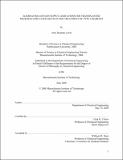| dc.contributor.advisor | Clark K. Colton. | en_US |
| dc.contributor.author | Lewis, Amy Suzanne | en_US |
| dc.contributor.other | Massachusetts Institute of Technology. Dept. of Chemical Engineering. | en_US |
| dc.date.accessioned | 2008-11-07T14:12:22Z | |
| dc.date.available | 2008-11-07T14:12:22Z | |
| dc.date.copyright | 2008 | en_US |
| dc.date.issued | 2008 | en_US |
| dc.identifier.uri | http://hdl.handle.net/1721.1/42941 | |
| dc.description | Thesis (Ph. D.)--Massachusetts Institute of Technology, Dept. of Chemical Engineering, 2008. | en_US |
| dc.description | This electronic version was submitted by the student author. The certified thesis is available in the Institute Archives and Special Collections. | en_US |
| dc.description | Includes bibliographical references (p. 227-234). | en_US |
| dc.description.abstract | Type I diabetes is a disease that results from a person's impaired ability to produce insulin, a protein that regulates the blood glucose concentration. Insulin is produced by [beta]-cells in the Islets of Langerhans, which are aggregates of cells averaging about 150 [mu]m in diameter and constituting about 1 to 2% of the pancreas volume. The efficacy of islet transplantation as a treatment for diabetes has been demonstrated in humans by the Edmonton Protocol, but obstacles remain for wide scale application. One major issue is that successful islet transplantation requires permanent use of multiple immunosuppressive agents. These agents may have serious side effects as well as a substantial financial burden. Microencapsulation is used for full or partial protection of transplanted islets from immune rejection. However, the microcapsule prevents islet revascularization and creates an additional mass transfer resistance for oxygen transport to islets. This reduced oxygen transfer can lead to a hypoxic core within the islet that results in tissue death and reduced function. We have studied two approaches to enhance microencapsulated islet survival and function by reducing oxygen transport limitations. The first method involves incorporating a perfluorocarbon emulsion into alginate microcapsules to enhance oxygen permeability in order to protect islets from hypoxia. The second method involves dispersing the islets into single cells and allowing them to reaggregate into cell clusters smaller than the original islet. The smaller aggregates are less prone to the development of a necrotic core and can function normally because of adequate oxygen supply and the presence of cell to cell contacts. | en_US |
| dc.description.abstract | (cont.) A theoretical reaction-diffusion model was developed to predict the oxygen partial pressure profile, extent of cell death, and rate of insulin secretion in alginate microcapsules or planar diffusion chambers containing an islet, islet cell aggregates, and dispersed single cells exposed to specified external PO2 values, with or without PFC. Results show that hypoxic conditions are reduced, therefore enhancing islet viability and substantially maintaining insulin secretion when PFC emulsion is incorporated in the encapsulation material or when smaller islet cell aggregates are used. Methods were developed to assess encapsulated tissue through nuclei counting, DNA quantification, and oxygen consumption rate measurements. Experiments with islets and islet cell aggregates were performed to assess whether the benefits predicted by the theoretical model can be observed experimentally. After two days of culture in a limited oxygen environment comparisons were made between islets and islet cell aggregates within normal alginate and islets within PFC alginate microcapsules in their viability by measurement of oxygen consumption rate, function by measuring glucose stimulated insulin secretion (only tissue in normal alginate capsules), and total tissue content by measuring DNA or performing nuclei counts. The PFC emulsion formulation that was used was toxic to islets and we were not conclusively able to demonstrate that it enhances survival in low oxygen. Islet cell aggregates survive and function better in low oxygen environments during in vitro experiments than intact islets. Encapsulated rat islet cell aggregates are also found to more effectively cure diabetes in mice than encapsulated islets. | en_US |
| dc.description.statementofresponsibility | by Amy Suzanne Lewis. | en_US |
| dc.format.extent | 234 p. | en_US |
| dc.language.iso | eng | en_US |
| dc.publisher | Massachusetts Institute of Technology | en_US |
| dc.rights | M.I.T. theses are protected by
copyright. They may be viewed from this source for any purpose, but
reproduction or distribution in any format is prohibited without written
permission. See provided URL for inquiries about permission. | en_US |
| dc.rights.uri | http://dspace.mit.edu/handle/1721.1/7582 | en_US |
| dc.subject | Chemical Engineering. | en_US |
| dc.title | Eliminating oxygen supply limitations for transplanted microencapsulated islets in the treatment of type 1 diabetes | en_US |
| dc.type | Thesis | en_US |
| dc.description.degree | Ph.D. | en_US |
| dc.contributor.department | Massachusetts Institute of Technology. Department of Chemical Engineering | |
| dc.identifier.oclc | 256949391 | en_US |
